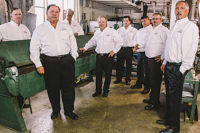
Work had to be scheduled around actual shuttle launches, which could be delayed at any time without warning.

Cram Roofing replaced the roof atop the Communication Building at NASA’s Kennedy Space Center in Cape Canaveral, Fla. The job totaled approximately 348 squares. (Photos courtesy of Cram Roofing.)
Headquartered in San Antonio, Cram Roofing employs approximately 100 people. The lion’s share of the firm’s work is commercial, most of it consisting of retrofit applications. The company does a little high-end residential work, including dormitories; less than 10 percent of its work is in new construction. “We’ve been in business since November 15, 1986 - 21 years,” says Gary Cram, the company’s owner. “And this was definitely one of our more interesting projects.”
The company reroofed the Communication Building at NASA’s Kennedy Space Center. The building houses some of the most sophisticated equipment in the world, and making sure the environment was not compromised and the computers and communication equipment were kept online and unharmed were paramount concerns.
The company’s reputation for top-flight safety procedures helped it secure the job, says Cram. “We do a lot of government work,” he says. “We were not the low bidder on this project, but based on our safety record, we got the job.”
The roof system installed on the existing gypsum deck was comprised of a vented base sheet, 3 inches of polyisocyanurate insulation, 1/2-inch DensDeck and three plies of Soprema’s Sopralene membrane, with the top ply consisting of a modified cap sheet. It wasn’t the installation of the system itself but the logistics of the jobsite that posed the biggest challenges on the project.
Mark Eichelbaum, Cram Roofing’s chief operating officer and quality control inspector, notes that the job also called for specialty welding of the building’s many antenna bases and a redundant system to protect the telecommunications equipment. “There was so much extensive electrical equipment - millions of dollars of high-tech electronics - and we had to develop an extensive water control program,” he says.
“The building itself houses all the telecommunications equipment that interconnects all of the NASA facilities throughout the world,” notes John Baer, who was NASA’s project inspector at the time and served as the site safety monitor “It had to stay online the whole time.”

Security requirements posed an administrative burden, as all workers had to pass background checks. All workers were issued passes to enter the complex and the Communications Building, and an escort with security clearance had to escort them on and off the premises.
Jobsite Challenges
Site security was perhaps the biggest obstacle that the company faced throughout the course of the project. “We needed to obtain FBI clearance weeks in advance,” Cram says. Workers were screened every time they entered the complex, and all workers had to be escorted within the perimeter by someone with security clearance.“A visitors badge was required to get on the base, and entering the Communications Building required a second badge,” says Eichelbaum. “We had two or three people on site - including myself - who had gone through the security checks and could act as escorts. Otherwise, we would have had to pay full-time escorts.”
All workers had to undergo a background check and a criminal record check, and they were then issued badges to get inside the secure areas; however, they had to be with an FBI-approved escort. It proved tough to stay on top of the paperwork. “Apparently they have a rule which requires them to send your paperwork back two or three times before they’d approve it,” Cram jokes. “Badges were issued for 30 or 90 days, and some badges ran out and employees had to be checked again for recent criminal activity.”
Eichelbaum also had to escort associated subcontractors, including welders and lightning protection workers, and coordinate deliveries of everything from dumpsters to propane tanks to portable toilets.
“The logistics of the project were very tough,” says Jon Pett, Cram Roofing’s operations manager. “Getting the badges in a timely manner was key - you don’t want people sitting around all day.”
There were other scheduling concerns, including working around launches of the space shuttles. “There were two or three actual launches during the course of the job, and several planned launches might be cancelled,” recalls Cram. “We’re from San Antonio, and we’re working in Cape Canaveral, so it’s not like we can go over to the next job.”
The weather was a constant threat. “It was a seven-day-a-week project, and rain was a concern every day,” notes Pett, who made sure crews monitored the weather and didn’t tear off more area than they could replace before the next rainfall. “Gauging the amount to tear off because of the rain was a big challenge,” he says. “Maybe you’d decide to do just 15 squares one day, as there was a 40 percent chance of rain at 2 o’clock. Then you’d get your nose to the grindstone and get it done. We kept 100-foot by 20-foot sections of EPDM to cover an area if we’d have to get off the roof in a hurry.”
Safety was a constant refrain on the jobsite, and Eichelbaum notes that the company had to comply with NASA’s requirements, which exceeded typical OSHA standards. “We were eligible for a safety bonus award on the project, and demerits were to be given for safety violations,” says Eichelbaum. “This was a high-visibility jobsite, and we had people staring at us from windows at all times, in addition to a linked closed-circuit TV camera aimed straight at us, but we received zero demerits.”
“This building was on the main drag, and it seemed like we had 10,000 inspectors every day,” recalls Pett. “At one meeting, they brought out pictures from a Huey helicopter to show us they were documenting safety procedures.”
There were other observers as well. “Even the alligators would come up on land and watch us roof,” Cram says. “There were alligators everywhere.”

Workers carefully flash the antenna bases.
Water Control Plan
In addition to the normal precautions of monitoring the weather to keep the building dry, NASA required that the company develop a water control plan within the building as an extra-layer of protection for the equipment inside. The plan called for tarps and Visqueen to cover equipment, and tubing was set up to serve as an interior storm drain system if water penetrated the building.“If we got a John Wayne storm - that’s one that sneaks up on you - we had Visqueen on the inside of the building and a tubing system that went down to 30- or 55-gallon barrels so the equipment that controls the shuttles would not get wet,” says Cram. “We had a roof inside the building, as well as the one on top of it.”
In the end, the interior precautions were not necessary, according to Eichelbaum. “We’re proud to say that all of our tarps and Visqueen stayed dry,” he says. “It was just a requirement of the job.”
The job also called for replacing gutters and downspouts around the perimeter. The numerous antenna bases posed problems, as they not only meant a lot of penetrations but necessitated some structural work below the roof as well.
“They had engineers from all over the world working on the satellites,” Cram says. A key question involved the welding the antenna bases to the trusses, and a subcontractor was called in for that portion of the work. On top of the roof, the antennae bases had to be carefully flashed. “One 20-foot by 20-foot area had 50 bases,” Pett notes.
NASA was so impressed with the company’s work that they asked the Cram employees to complete some additional items outside of the original scope of work. “At the end of the project, they gave us a change order to go in and do some interior work,” Pett says. “We removed some ductwork and replaced the ceiling grid.”
NASA also nominated Cram Roofing for its Contractor of the Year award based on its outstanding performance during the job.
Baer sums the project up this way: “Application of the roofing system was pretty similar to a standard job. All of the security and safety issues taken together posed the major problems. A lot of administrative effort was involved in making sure people were where they were supposed to be.”
“All the things you take for granted in a normal job were different here,” he continues. “It was an administrative burden you don’t see on every job.”
“We have a saying here that ‘Roofing isn’t rocket science,’ but it was this time,” concludes Cram.




